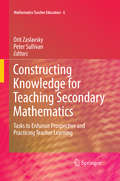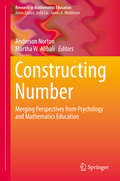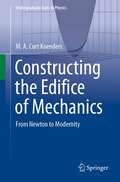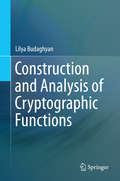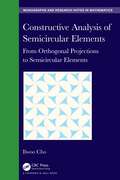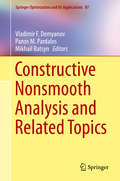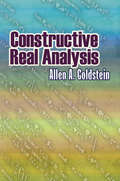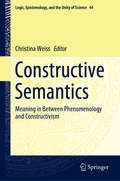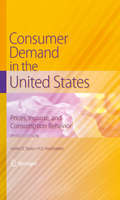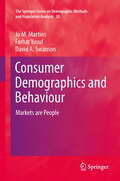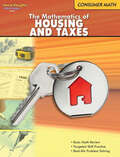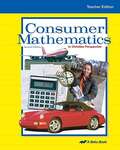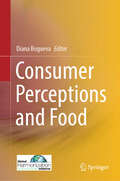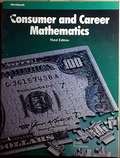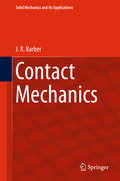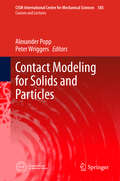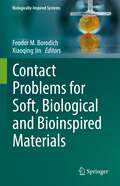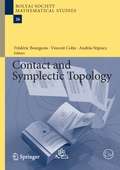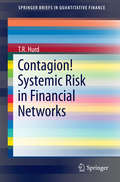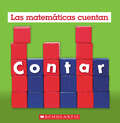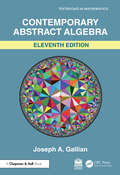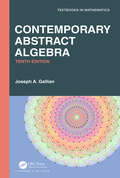- Table View
- List View
Constructing Insurable Risk Portfolios (Chapman & Hall/CRC Series in Actuarial Science)
by Edward W. FreesConstructing Insurable Risk Portfolios offers a data-driven approach to devising risk retention programs that safeguard firms from a multitude of risks. Because firms face many risks, including fire damage to their buildings, liability from management misconduct, and external threats like cyberattacks, this book treats these potential liabilities as a "portfolio." Drawing inspiration from Markowitz portfolio theory, the text leverages techniques from probability, statistics, and optimization to build algorithms that construct optimal risk insurable portfolios under budget constraints.Features Through engaging case studies and supporting statistical (R) code, readers will learn how to build optimal insurable risk portfolios. This book illustrates a frontier that depicts the trade-off between the uncertainty of a portfolio and the cost of risk transfer. This visual representation, mirroring familiar Markowitz investment tools, enables informed decision-making and easy adoption by risk advisors. This book lays the mathematical groundwork for constructing optimal insurable risk portfolios in an effective and aesthetically pleasing manner. For those interested in the detailed mathematical aspects of insurable risk portfolio optimization, comprehensive proofs and derivations are available in an online supplement. This book equips students, academics, and practitioners with quantitative tools to analyze real-world risk portfolios. Additionally, it empowers financial analysts to provide data-driven insights that enhance their advisory roles for risk managers.
Constructing Knowledge for Teaching Secondary Mathematics: Tasks to enhance prospective and practicing teacher learning (Mathematics Teacher Education #6)
by Orit Zaslavsky Peter SullivanTeacher education seeks to transform prospective and/or practicing teachers from neophyte possibly uncritical perspectives on teaching and learning to more knowledgeable, adaptable, analytic, insightful, observant, resourceful, reflective and confident professionals ready to address whatever challenges teaching secondary mathematics presents. This transformation occurs optimally through constructive engagement in tasks that foster knowledge for teaching secondary mathematics. Ideally such tasks provide a bridge between theory and practice, and challenge, surprise, disturb, confront, extend, or provoke examination of alternatives, drawn from the context of teaching. We define tasks as the problems or activities that, having been developed, evaluated and refined over time, are posed to teacher education participants. Such participants are expected to engage in these tasks collaboratively, energetically, and intellectually with an open mind and an orientation to future practice. The tasks might be similar to those used by classroom teachers (e.g., the analysis of a graphing problem) or idiosyncratic to teacher education (e.g., critique of videotaped practice). This edited volume includes chapters based around unifying themes of tasks used in secondary mathematics teacher education. These themes reflect goals for mathematics teacher education, and are closely related to various aspects of knowledge required for teaching secondary mathematics. They are not based on the conventional content topics of teacher education (e.g., decimals, grouping practices), but on broad goals such as adaptability, identifying similarities, productive disposition, overcoming barriers, micro simulations, choosing tools, and study of practice. This approach is innovative and appeals both to prominent authors and to our target audiences.
Constructing Number: Merging Perspectives From Psychology And Mathematics Education (Research In Mathematics Education Ser.)
by Anderson Norton Martha W. AlibaliThe book synergizes research on number across two disciplines—mathematics education and psychology. The underlying problem the book addresses is how the brain constructs number. The opening chapter frames the problem in terms of children’s activity, including mental and physical actions. Subsequent chapters are organized into sections that address specific domains of number: natural numbers, fractions, and integers. Chapters within each section address ways that children build upon biological primitives (e.g., subitizing) and prior constructs (e.g., counting sequences) to construct number. The book relies on co-authored chapters and commentaries at the end of each section to create dialogue between junior faculty and senior researchers, as well as between psychologists and mathematics educators. The final chapter brings this work together around the framework of children’s activity and additional themes that arise in the collective work. The book is aimed to appeal to mathematics educators, mathematics teacher educators, mathematics education researchers, educational psychologists, cognitive psychologists, and developmental psychologists.
Constructing the Edifice of Mechanics: From Newton to Modernity (Undergraduate Texts in Physics)
by M.A. Curt KoendersThis book deals with theoretical mechanics. Newton published the "Philosophiæ Naturalis Principia Mathematica" in 1687. In it, he sets out the basic principles of physics that are required to understand the motion of the planets, their moons, and the comets in the solar system. It includes the gravitational (inverse square) law, the inertial principle, and the basic elements of mechanics. Since its publication, a large number of refinements and reformulations have been introduced, thereby adding enormous insight into the structure of mechanics, which is commonly known as “classical mechanics”. All these have in common that by taking a suitable limit, Newton's original principles re-appear. Thus, physicists and mathematicians who work on the subject always have a notion that if their theories do not return to Newton's foundations, then there is something wrong. Newton himself acknowledged that 'if I have seen further (than others), it is by standing on the shoulders of giants'. One of these giants was undoubtedly Galileo who died in the year Newton was born. So, Newton himself adhered to the 'classical limit'.
Construction and Analysis of Cryptographic Functions
by Lilya BudaghyanThis book covers novel research on construction and analysis of optimal cryptographic functions such as almost perfect nonlinear (APN), almost bent (AB), planar and bent functions. These functions have optimal resistance to linear and/or differential attacks, which are the two most powerful attacks on symmetric cryptosystems. Besides cryptographic applications, these functions are significant in many branches of mathematics and information theory including coding theory, combinatorics, commutative algebra, finite geometry, sequence design and quantum information theory. The author analyzes equivalence relations for these functions and develops several new methods for construction of their infinite families. In addition, the book offers solutions to two longstanding open problems, including the problem on characterization of APN and AB functions via Boolean, and the problem on the relation between two classes of bent functions.
Constructive Analysis of Semicircular Elements: From Orthogonal Projections to Semicircular Elements (Chapman & Hall/CRC Monographs and Research Notes in Mathematics)
by Ilwoo ChoThis book not only examines the constructions and free-probabilistic properties of semicircular elements, as defined within the text, but also considers certain Banach-space operators acting on these semicircular elements and shows how they deform (i.e., preserve-or-distort) the semicircular law induced by orthogonal projections. FEATURES Suitable for graduate students and professional researchers in operator theory and/or analysis Numerous applications in related scientific fields and areas
Constructive Nonsmooth Analysis and Related Topics (Springer Optimization and Its Applications #87)
by Panos M. Pardalos Vladimir F. Demyanov Mikhail BatsynThis volume contains a collection of papers based on lectures and presentations delivered at the International Conference on Constructive Nonsmooth Analysis (CNSA) held in St. Petersburg (Russia) from June 18-23, 2012. This conference was organized to mark the 50th anniversary of the birth of nonsmooth analysis and nondifferentiable optimization and was dedicated to J. -J. Moreau and the late B. N. Pshenichnyi, A. M. Rubinov, and N. Z. Shor, whose contributions to NSA and NDO remain invaluable. The first four chapters of the book are devoted to the theory of nonsmooth analysis. Chapters 5-8 contain new results in nonsmooth mechanics and calculus of variations. Chapters 9-13 are related to nondifferentiable optimization, and the volume concludes with four chapters containing interesting and important historical chapters, including tributes to three giants of nonsmooth analysis, convexity, and optimization: Alexandr Alexandrov, Leonid Kantorovich, and Alex Rubinov. The last chapter provides an overview and important snapshots of the 50-year history of convex analysis and optimization.
Constructive Real Analysis
by Allen A. GoldsteinThis text introduces students of mathematics, science, and technology to the methods of applied functional analysis and applied convexity. The three-part treatment consists of roots and extremal problems, constraints, and infinite dimensional problems. Topics include iterations and fixed points, metric spaces, nonlinear programming, polyhedral convex programming, linear spaces and convex sets, and applications to integral equations. 1967 edition.
Constructive Semantics: Meaning in Between Phenomenology and Constructivism (Logic, Epistemology, and the Unity of Science #44)
by Christina WeissThis edited book brings together research work in the field of constructive semantics with scholarship on the phenomenological foundations of logic and mathematics. It addresses one of the central issues in the epistemology and philosophy of mathematics, namely the relationship between phenomenological meaning constitution and constructive semantics. Contributing authors explore deep structural connections and fundamental differences between phenomenology and constructivism. Papers are drawn from contributions to a prestigious workshop held at the University of Friedrichshafen. Readers will discover insight into structural connections between the phenomenological concept of meaning constitution and constructivist concepts of meaning. Discussion ranges from more specific conceptualizations in the philosophy of logic and mathematics to more general considerations in epistemology, inferential semantics and phenomenology. Questions such as a possible phenomenological understanding of the relationship between structural rules and particle rules in dialogical logic are explored. Significant aspects of both phenomenology and dialectics, and dialectics and constructivism emerge. Graduates and researchers of philosophy, especially logic, as well as scholars of mathematics will all find something of interest in the expert insights presented in this volume.
Consumer Demand in the United States: Prices, Income, and Consumption Behavior
by Lester D. Taylor H. S. HouthakkerA classic treatise that defined the field of applied demand analysis, Consumer Demand in the United States: Prices, Income, and Consumption Behavior is now fully updated and expanded for a new generation. Consumption expenditures by households in the United States account for about 70% of America's GDP. The primary focus in this book is on how households adjust these expenditures in response to changes in price and income. Econometric estimates of price and income elasticities are obtained for an exhaustive array of goods and services using data from surveys conducted by the Bureau of Labor Statistics and aggregate consumption expenditures from the National Income and Product Accounts, providing a better understanding of consumer demand. Practical models for forecasting future price and income elasticities are also demonstrated. Fully revised with over a dozen new chapters and appendices, the book revisits the original Houthakker-Taylor models while examining new material as well, such as the use of quantile regression and the stationarity of consumer preference. It also explores the emerging connection between neuroscience and consumer behavior, integrating the economic literature on demand theory with psychology literature. The most comprehensive treatment of the topic to date, this volume will be an essential resource for any researcher, student or professional economist working on consumer behavior or demand theory, as well as investors and policymakers concerned with the impact of economic fluctuations.
Consumer Demographics and Behaviour: Markets are People (The Springer Series on Demographic Methods and Population Analysis #30)
by David A. Swanson Farhat Yusuf Jo M. MartinsThis is the book that market strategists have been waiting for to position themselves in global markets and take advantage of the opportunities that demographic bonuses and deficits offer to them and their products. It is also a book for teachers and students of consumer behaviour to grasp the importance of the life cycle as a framework that shapes the demand for goods and services determined by changes in social, economic and physical functioning. It gives insights into gendered consumer behaviour and cohort effects. It presents a range of views on consumer behaviour and how demographic perspectives enhance these perspectives. The book offers conceptual and analytical tools that can be used in the assessment of population characteristics as determinants of market size, composition and potential for a variety of products. It offers organising frameworks as well as empirical evidence of consumer behaviour in clusters of markets, with different rates of population growth and age distribution that affect consumers' priorities and demand for basic and progressive commodities. The book shows commonalities as well as differences in consumer behaviour arising from different cultures and social customs. It uses analytical tools that are explained and accessible to readers with a range of competences. It is a book that can give a better understanding of consumer behaviour and market opportunities to the practitioner. It can also be used for the instruction of students in demography, consumer behaviour and marketing.
Consumer Math
by Bob Jones University Press Staff William L. BurkholderConsumer Math Student Edition, 3rd ed. features explanations of concepts with helpful examples, exercise sets, Stewardship & Scripture features, and chapter and cumulative reviews
Consumer Math: The Mathematics of Housing and Taxes (Consumer Math Ser.)
by Steck-VaughnThis very practical series will help adolescents and adults alike to understand mathematics as it relates to their everyday lives. Each book covers basic math concepts and skills before exploring the more specific topics. Clear explanations are followed by ample practice. Each section also has a pretest, a section review, and a posttest.
Consumer Mathematics
by Francis G. FrenchLearn about the basics of Mathematics, money, net pay, personal banking, budgeting, making a purchase, buying food, buying clothing, buying a car, public transportation, renting an apartment, buying a house and much more.
Consumer Mathematics: In Christian Perspective
by Judy HoweA Christian Perspective of Consumer Mathematics. This can be taken any year in high school.
Consumer Perceptions and Food
by Diana BoguevaThis book is a timely overview of the various aspects of consumer perception related to food. This book explores consumer perceptions that are vital to marketers and often underlie the success or failure of products in the marketplace. Perception is the process of selecting, organizing, and interpreting sensations into a meaningful whole, and this book highlights how human perceptions are unique, highly subjective, and easily distorted. These perceptions are influenced by our senses—sight, hearing, taste, smell, and touch—as well as our beliefs, emotions, opinions, and experiences. This book states that this is related to food, and perceptions are also guided by beliefs, thoughts, emotions, feelings, and opinions about, or preferences, expectations, and knowledge of, and the sensory experience, the fear, and the relationships built between the consumers and the food over time. This book aims to further the understanding of the fundamental mechanisms which determine individual responses to existing and emerging food issues. This book provides insights into consumer behaviour (e.g. consumer decision making, promoting behaviour change), factors influencing consumers’ food and meal choices, confidence in the safety of food, perception of health-related messages and food laws and regulations, sustainable and responsible consumer behaviour (e.g. food waste), acceptability of new food alternatives, innovations and technologies, integrating consumer insight and communication challenges in cross-functional communications in innovation processes. "Consumer Perceptions and Food" delves into how these perceptions shape consumer behavior, from decision-making and behavior change to meal choices and confidence in food safety. It explores the impact of health-related messages, food laws, and regulations, and examines the acceptability of new food alternatives and technologies. The book also addresses the importance of sustainable and responsible consumer behavior, including food waste and ethical consumption. Through a rich array of insights, this book provides a deep understanding of the fundamental mechanisms that drive individual responses to food issues. It emphasizes the importance of mindful eating—making conscious food choices that benefit our health, the environment, and the planet. This involves considering the origins of our food, its production methods, and the broader impacts of our choices on public health and ecosystems. This book is a call to action for consumers to rethink their relationship with food, fostering deeper connections and appreciation for sustainable practices and ethical consumption. It is a crucial step in the ongoing journey of shaping the future of food, guided by informed and mindful consumers.
Consumer and Career Mathematics Workbook (3rd Edition)
by Scott ForesmanConsumer and Career Mathematics Workbook Third Edition. Workbook to accompany hardcover mathematics school book of same title. For grades 9-12 covering basic computation skills, probability, statistics, basic facts of geometry, both U.S. & metric measurement, & consumer lessons. Consumer lessons use a five-part problem-solving plan: Understand, Plan, Solve, Look Back, & Answer. Practical problem solving: Budgeting, Personal Banking, Interest, Mortgages, Investments, Financing a Car, & Insurance. This workbook is for practicing of basic skills.
Contact Mechanics
by J. R. BarberThis book describes the solution of contact problems with an emphasis on idealized (mainly linear) elastic problems that can be treated with elementary analytical methods. General physical and mathematical features of these solutions are highlighted. Topics covered include the contact of rough surfaces and problems involving adhesive (e.g. van der Waals) forces. The author is a well-known researcher in the subject with hands-on experience of the topics covered and a reputation for lucid explanations. The target readership for the book includes researchers who encounter contact problems but whose primary focus is not contact mechanics. Coverage is also suitable for a graduate course in contact mechanics and end-of-chapter problems are included.
Contact Modeling for Solids and Particles (CISM International Centre for Mechanical Sciences #585)
by Peter Wriggers Alexander PoppThe book conveys modern techniques and the latest state-of-the-art with regard to the most fundamental aspects of computational contact mechanics. However, since contact can readily be interpreted as a special type of interface problem, it seems advisable not to isolate contact mechanics, but rather to address it in the context of a broader class of problems denoted as computational interface mechanics. The book gives a clear understanding of the underlying physics of interfaces, and a comprehensive insight into the current state-of-the-art and selected cutting-edge research directions in the computational treatment of interface effects. It focuses on the modeling of friction, wear, lubrication, cohesive interfaces, grain boundaries, phase boundaries, fracture, thermo-mechanics and particulate contact (e.g. granular media). Also the most important computational aspects are addressed, including discretization techniques for finite deformations, solution algorithms for single- and multi-processor computing environments, multi-scale approaches, discrete element models and multi-physics problems including contact and interface constraints. Among the computational techniques covered in this book are finite element (FEM) and boundary element (BEM) methods, atomistic models, molecular dynamics (MD), discrete element methods (DEM), coupling approaches for multi-scale simulations, and tools for an efficient automated FEM code generation.
Contact Problems for Soft, Biological and Bioinspired Materials (Biologically-Inspired Systems #15)
by Feodor M. Borodich Xiaoqing JinThis book contains contributions from leading researchers in biomechanics, nanomechanics, tribology, contact mechanics, materials science and applications on various experimental techniques including atomic force microscopy (AFM) for studying soft, biomimetic and biological materials and objects. Biologists, physicists, researchers applying methods of contact mechanics and researchers testing materials using indentation techniques along with many other applied scientists will find this book a useful addition to their libraries. Moreover, several reviews in this book are written as introductions to several important and rather sophisticated research areas such as depth-sensing indentation, studying of biological cells by AFM probes, mechanics of adhesive contact and contact between viscoelastic (hereditary elastic) solids. The book containing new theoretical models, results of experimental studies and numerical simulations, along with reviews of above mentioned areas of contact mechanics in application to biological systems, would be beneficial for researchers in many areas of biology, medicine, engineering, mechanics and biomimetics.
Contact and Symplectic Topology: Lectures From The Nantes Trimester 2011 And The Budapest Summer School 2012 (Bolyai Society Mathematical Studies #26)
by Frédéric Bourgeois Vincent Colin András StipsiczSymplectic and contact geometry naturally emerged from the mathematical description of classical physics. The discovery of new rigidity phenomena and properties satisfied by these geometric structures launched a new research field worldwide. The intense activity of many European research groups in this field is reflected by the ESF Research Networking Programme "Contact And Symplectic Topology" (CAST). The lectures of the Summer School in Nantes (June 2011) and of the CAST Summer School in Budapest (July 2012) provide a nice panorama of many aspects of the present status of contact and symplectic topology. The notes of the minicourses offer a gentle introduction to topics which have developed in an amazing speed in the recent past. These topics include 3-dimensional and higher dimensional contact topology, Fukaya categories, asymptotically holomorphic methods in contact topology, bordered Floer homology, embedded contact homology, and flexibility results for Stein manifolds.
Contagion! Systemic Risk in Financial Networks
by T. R. HurdThis volume presents a unified mathematical framework for the transmission channels for damaging shocks that can lead to instability in financial systems. As the title suggests, financial contagion is analogous to the spread of disease, and damaging financial crises may be better understood by bringing to bear ideas from studying other complex systems in our world. After considering how people have viewed financial crises and systemic risk in the past, it delves into the mechanics of the interactions between banking counterparties. It finds a common mathematical structure for types of crises that proceed through cascade mappings that approach a cascade equilibrium. Later chapters follow this theme, starting from the underlying random skeleton graph, developing into the theory of bootstrap percolation, ultimately leading to techniques that can determine the large scale nature of contagious financial cascades.
Contar (Math Counts)
by Henry PluckroseUna serie de libros para introducir a los lectores jovenes a conceptos matematicos fundamentales, ¡ahora en espanol!¿A que numero llegas cuando cuentas todos los dedos de una mano? ¿Alguna vez has contado cuantos pasos haces mientras subes y bajas unas escaleras? Contar nos ayuda a saber "¿cuantos?" Con ejemplos del mundo real, fotografias convincentes y textos inspiradores, ¡esta es la introduccion perfecta al concepto matematico de "contar" para los lectores mas jovenes!Sobre la serie:Publicada originalmente en los anos 90 y actualizada recientemente, esta revolucionaria serie superventas inicia a los ninos en el camino de aprender a comunicarse y razonar matematicamente.La base de las matematicas son las ideas, y estos libros se han desarrollado para que los ninos vean, hablen, toquen y experimenten con estas ideas. Las fotografias atractivas y el texto sencillo y directo, hacen de esta serie una herramienta perfecta para leer individualmente o en voz alta. Diez conceptos matematicos fundamentales, uno para cada libro de la serie, estan desarrollados de forma excelente, y ofrecen un apoyo curricular ideal. Esta serie es la mejor manera de iniciar el camino hacia el dominio de las matematicas.
Contemporary Abstract Algebra (Textbooks in Mathematics)
by Joseph GallianContemporary Abstract Algebra, Eleventh Edition is intended for a course whose main purpose is to enable students to do computations and write proofs. This text stresses the importance of obtaining a solid introduction to the traditional topics, while at the same time presenting abstract algebra as a contemporary and very much active subject, which is currently being used by working physicists, chemists, and computer scientists.For nearly four decades, this classic text has been widely appreciated by instructors and students alike. The book offers an enjoyable read and conveys and develops enthusiasm for the beauty of the topics presented. It is comprehensive, lively, and engaging.Students will learn how to do computations and write proofs. A unique feature of the book are exercises that build the skill of generalizing, a skill that students should develop, but rarely do.Examples elucidate the definitions, theorems, and proof techniques; exercises facilitate understanding, provide insight, and develop the ability to do proofs. The hallmark features of previous editions of the book are enhanced in this edition. These include: A good mixture of approximately 1900 computational and theoretical exercises appearing in each chapter that synthesizes concepts from multiple chapters Back-of-the-book skeleton solutions and hints to odd-numbered exercises Over 300 worked-out examples ranging from routine computations to the more challenging Links to interactive True/False questions with comments Links to computer exercises that utilize interactive software available on the author's website, stressing guessing and making conjectures Many applications from scientific and computing fields, as well as some from everyday life Numerous historical notes and biographies that spotlight the people and events behind the mathematics Motivational and humorous quotations Hundreds of figures, photographs, and tables Changes to the eleventh edition include new exercises, examples, biographies, and quotes, and an enrichment of the discussion portions. These changes accentuate and enhance the hallmark features that have made previous editions of the book a comprehensive, lively, and engaging introduction to the subject.While many partial solutions and sketches for the odd-numbered exercises appear in the book, an Instructor’s Solutions Manual offers solutions for all the exercises. A Student's Solution Manual has comprehensive solutions for all odd-numbered exercises, many even-numbered exercises, and numerous alternative solutions as well.
Contemporary Abstract Algebra: Answer Key (Textbooks in Mathematics)
by Joseph A. GallianContemporary Abstract Algebra, Tenth Edition For more than three decades, this classic text has been widely appreciated by instructors and students alike. The book offers an enjoyable read and conveys and develops enthusiasm for the beauty of the topics presented. It is comprehensive, lively, and engaging. The author presents the concepts and methodologies of contemporary abstract algebra as used by working mathematicians, computer scientists, physicists, and chemists. Students will learn how to do computations and to write proofs. A unique feature of the book are exercises that build the skill of generalizing, a skill that students should develop but rarely do. Applications are included to illustrate the utility of the abstract concepts. Examples and exercises are the heart of the book. Examples elucidate the definitions, theorems, and proof techniques; exercises facilitate understanding, provide insight, and develop the ability to do proofs. The exercises often foreshadow definitions, concepts, and theorems to come. Changes for the tenth edition include new exercises, new examples, new quotes, and a freshening of the discussion portions. The hallmark features of previous editions of the book are enhanced in this edition. These include: A good mixture of approximately 1900 computational and theoretical exercises, including computer exercises, that synthesize concepts from multiple chapters Approximately 300 worked-out examples from routine computations to the challenging Many applications from scientific and computing fields and everyday life Historical notes and biographies that spotlight people and events Motivational and humorous quotations Numerous connections to number theory and geometry While many partial solutions and sketches for the odd-numbered exercises appear in the book, an Instructor’s Solutions Manual written by the author has comprehensive solutions for all exercises and some alternative solutions to develop a critical thought and deeper understanding. It is available from CRC Press only. The Student Solution Manual has comprehensive solutions for all odd-numbered exercises and many even-numbered exercises.

